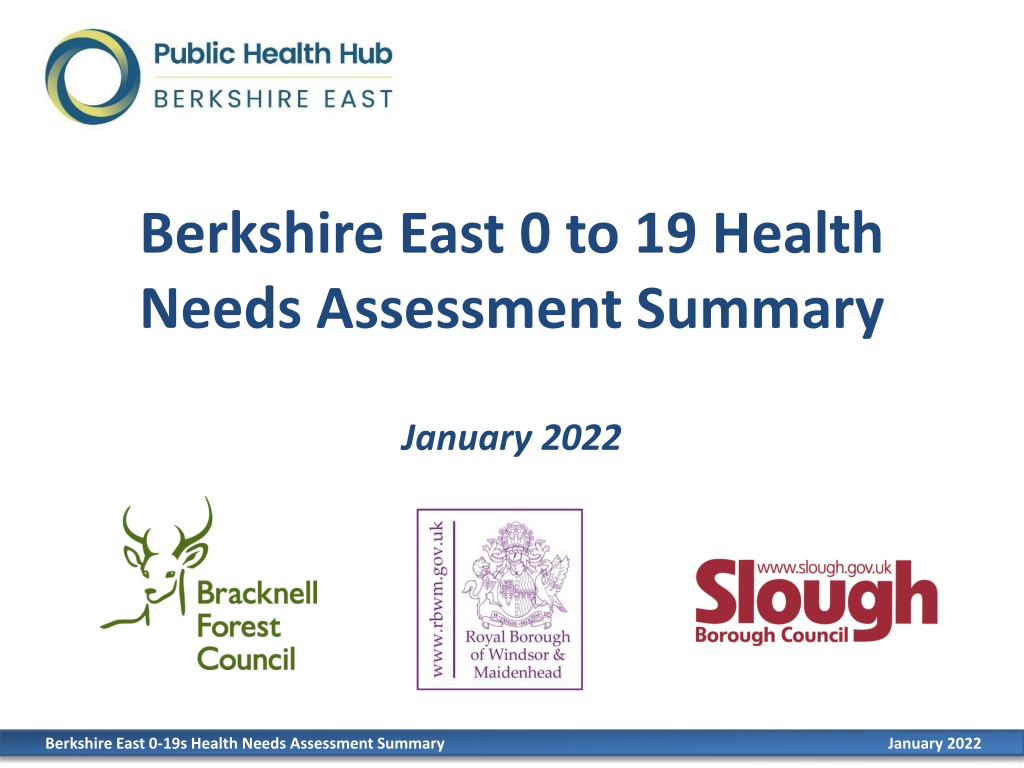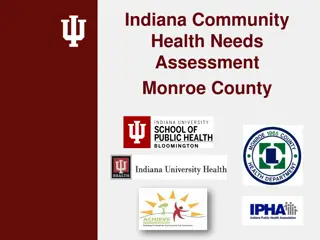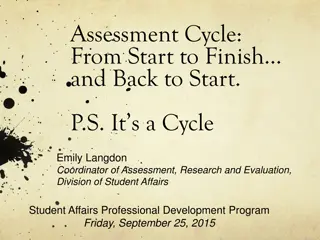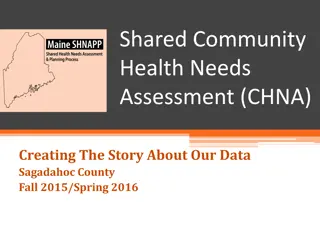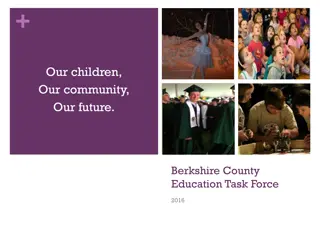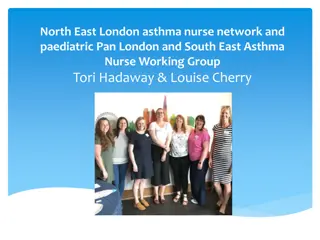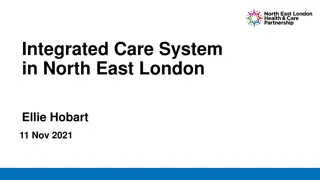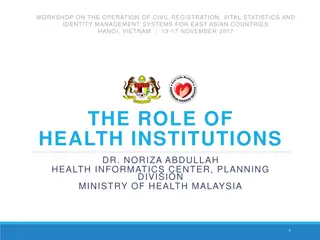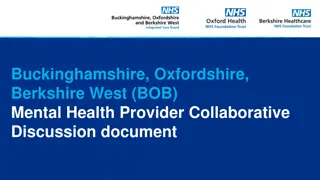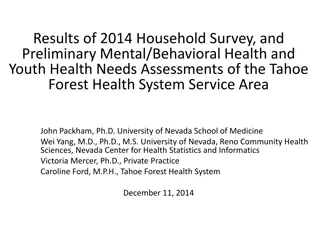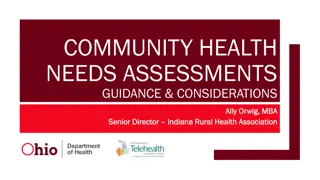Berkshire East 0-19 Health Needs Assessment Summary
The Berkshire East 0-19 Health Needs Assessment provides insights into the health needs of children and young people in the region. Jointly developed by Public Health Teams in Berkshire East, the assessment aims to understand current and future needs, evaluate service provisions, incorporate feedback from families and professionals, and identify opportunities for improvement. The assessment focuses on the Berkshire East geography, demographics, health outcomes, and service provisions like the Healthy Child Programme. It outlines the challenges faced and opportunities for enhancing services for the 0-19 age group.
Download Presentation

Please find below an Image/Link to download the presentation.
The content on the website is provided AS IS for your information and personal use only. It may not be sold, licensed, or shared on other websites without obtaining consent from the author. Download presentation by click this link. If you encounter any issues during the download, it is possible that the publisher has removed the file from their server.
E N D
Presentation Transcript
Berkshire East 0 to 19 Health Needs Assessment Summary January 2022 Berkshire East 0-19s Health Needs Assessment Summary January 2022
Aims and purpose of the Berkshire East 0-19s HNA The 0-19s Health Needs Assessment (HNA) has been jointly developed by the Public Health Teams in Berkshire East Bracknell Forest Council, Slough Council, the Royal Borough of Windsor and Maidenhead and the overarching Berkshire East Public Health Hub. Children and Young People aged 0 to 19 were identified as the first priority area to look at through a Berkshire East lens , following the creation of the new Berkshire East Public Health System in April 2021. A working group was established to deliver the HNA and this was co-ordinated by Bracknell Forest s Public Health Team. The aims of the HNA were to: understand the level of current and future need of children and young people across the whole of Berkshire East, as well as within the three local authority areas summarise the existing service provision across the three local authorities incorporate feedback from local families and professionals, where available assess how we are currently doing against best practice and identify opportunities for improvement inform the commissioning and service specifications for 0 to 19 Service contracts (particularly Health Visiting and School Nursing) across Berkshire East Berkshire East 0-19s Health Needs Assessment Summary January 2022
Scope of the Berkshire East 0-19s HNA The HNA covers the whole Berkshire East population aged 0 to 19 and provides a summary of the demography, health and life outcomes for this age group. The HNA s primary focus is the Berkshire East geography, however it also provides information about the difference within and between the three local authority areas. Children who are identified as being more at risk of worse health outcomes have also been highlighted and quantified where possible. This is to help understand the different experiences and inequalities that are present for children and young people locally. The HNA s service provision and best practice sections focus particularly on the Healthy Child Programme and the services that are commissioned through this (Health Visiting and School Nursing). The HNA does not include detailed information about mental health prevalence or services for children and young people s mental health needs, as this is not commissioned through the 0 to 19 Service. Berkshire East 0-19s Health Needs Assessment Summary January 2022
Current service provision for Healthy Child Programme The Healthy Child Programme (HCP) is the national evidence-based universal programme for children aged 0 to 19. The 0 to 5 element is led by health visiting services and the 5 to 19 element is led by school nursing services. Together they provide place-based services and work in partnership with education and other providers where needed. The universal reach of the HCP provides an invaluable opportunity from early in a child s life to identify families that may need additional support and children who are at risk of poor outcomes. The three local authorities in Berkshire East commission different providers to deliver the Healthy Child Programme. This includes the delivery of the mandated aspects of the service, as well as locally-agreed services or approaches that meet the needs and priorities identified within that specific area. The HNA summarises the services delivered locally and includes activity data from each of the providers. Slough RBWM Bracknell Forest Solutions 4 Health are commissioned to deliver the 0 to 19 Service, incorporating Health Visiting and School Nursing Services, in an integrated offer. The existing contract ends on the 30th September 2022. Achieving 4 Children (AfC) are commissioned to deliver the Health Visiting and School Nursing Services. The current contract comes to an end in 31st March 2024. Berkshire Healthcare Foundation Trust (BHFT) are commissioned to deliver the Health Visiting and School Nursing Services. The current contract comes to an end on 31st March 2023. Berkshire East 0-19s Health Needs Assessment Summary January 2022
What do we know about Children and Young People in Berkshire East? 11% of children aged 0 to 15 in Berkshire East are affected by income deprivation (over10,000 children). All 3 local authority areas have pockets of deprivation that impact on children living there. Berkshire East has a younger population than the national profile. There are 426,035 people aged 0 to 19 in Berkshire East and they make-up 27% of the total population. There are over 5,000 live births a year in Berkshire East. Although fertility rates are decreasing, Slough currently has the highest total fertility rate in England. 34% of primary and 26% of secondary school children do not have English as a first language. 15% of all pupils in Berkshire East schools have a special educational need. 26% of Berkshire East 0 to 19s come from a non White-British background. There are approximately 450 looked after children and 550 children who are currently subject to a child protection plan in Berkshire East. Ethnic diversity varies significantly across the area. 17% ofBracknell Forest s 0 to 19s are non White-British, compared to 73% in Slough. Berkshire East 0-19s Health Needs Assessment Summary January 2022
Key demographics for Children and Young People in Berkshire East Population Berkshire East s population is youngerthan the national profile with a higher proportion of the population aged 5 to 14. Population Pyramid for Berkshire East (mid-2020 estimates) Projections show that the number of 0 to 19s will decrease over the next 20 years and that the proportion of the total population in this age group will also reduce. However, Berkshire East will continue to have a younger population than the national profile. Ethnicity and Language The levels of ethnic diversity vary across Berkshire East. Bracknell Forest has a lower proportion of children and young people from a non-White British group compared to England, while Slough has one of the highest proportions in England. Deprivation 11% of Berkshire East children aged 0 to 15 are living in income-deprived households, which is a reduction on the 2015 figure. This is over 10,000 children. Children and young people from Asian/Asian British background makeup the largest minority group in Berkshire East and this is the case across all three local authorities. The ethnic profile of all areas in Berkshire East is continuing to change and this can be evidenced by the ethnic backgrounds of children in Berkshire East schools and the proportion of births from mothers who were born outside of the UK. Levels of deprivation vary significantly across Berkshire East. Slough has more deprived areas than the rest of Berkshire East, however Bracknell Forest and RBWM both have neighbourhoods where approximately 20% of children are affected by deprivation. Over 21,500 children who attend Berkshire East schools do not have English as a first language. 75% of these are in Slough schools. Berkshire East 0-19s Health Needs Assessment Summary January 2022
Summary of health indicators for Children and Young People in Berkshire East The full HNA provides a detailed analysis of the health and wellbeing of children and young people in Berkshire East using a wide-variety of data sources. A summary of key indicators is shown on the next 2 slides, including the mandated visits and outcomes that are captured through the Health Visiting Service. Information is provided at a local authority level and compares against the latest national figures. Additional information is then shown for indicators where Berkshire East was identified as being significantly worse than England, where trends were worsening or where there was a significant difference across or within Berkshire East local authorities. Berkshire East 0-19s Health Needs Assessment Summary January 2022
Summary of health indicators for birth and early years in Berkshire East New Birth New Birth Visits Breastfeeding initiation Smoking status at time of delivery % of mothers known to be smokers at the time of delivery (2020/21) 6.5% Slough: 6.5% RBWM: 6.5% Low birth weight of term babies Babies born in 2019 with a low birth weight (<2500g) Slough: RBWM: % of births that receive a face to face NBV within 14 days (2020/21) Slough: RBWM: % of babies whose first feed is breastmilk (2018/19) 72.2% Slough: RBWM: 1,191 NBVs (93.4%) 2,013 NBVs (89.7%) 1,264 NBVs (89.2%) Bracknell: Bracknell: Bracknell: 27 babies (2.3%) 81 babies (3.9%) 33 babies (2.4%) Bracknell: 76.2% 78.7% 12 months 6-8 weeks 12 month reviews Breastfeeding prevalence 6 to 8 week reviews Infant mortality % of children who received as 12 month review by 15 months (2020/21) 1,201 reviews (90.0%) Slough: 1,843 reviews (85.2%) RBWM: 1,270 reviews (81.3%) % of all infants due a 6-8 week check that are totally or partially breastfed in 2020/21 58.6% Slough: 65.4% RBWM: Data not available % of all infants who received a 6-8 week review by 8 weeks old (2020/21) 1,222 reviews (91.0%) Slough: 1,933 reviews (90.7%) RBWM: 1,221 reviews (86.2%) Rate of deaths in infants aged under 1 year per 1,000 live births (2018-20) Slough: RBWM: Bracknell: Bracknell: Bracknell: 7 deaths (1.7) 29 deaths (4.1) 9 deaths (2.0) Bracknell: The latest available data is shown at a local authority Child development at 2 - 2 years - outcomes % of children who received a review and who were at or above expected level in all 5 areas of development (2020/21) 759 children (93.1%) Slough: 1,335 children (79.9%) RBWM: 859 children (81.2%) Child development at 2 - 2 years % of children who received a review by the time they turned 2 1/2 years (2020/21) This is compared against the England figure: Significantly better than England No significant difference to England Significantly worse than England Not comparable/ Value unknown 828 reviews (57.1%) 1,843 reviews (72.4%) 1,263 reviews (74.3%) Bracknell: Slough: RBWM: Bracknell:
Summary of health indicators for school-aged children in Berkshire East YR School Readiness (Year 1) % of children achieving expected levels in phonics screening check in Year 1 (2018/19) All Free School Meals 84.7% Slough: 85.7% RBWM: 83.5% 16.2% Obesity and overweight (Year R) % of children in Year R who are obese and overweight (2019/20) Obese Overweight and obese 10.2% 19.4% Slough: 11.9% 23.0% RBWM: 7.1% School Readiness (Reception) % of children achieving a good level of development at end of Year R (2018/19) All Free School Meals 76.4% Slough: 74.3% RBWM: 74.3% Dental Decay % of 5 year olds with dental decay which can be detected by visual observation alone (2018/19) 11.5% Slough: 37.9% RBWM: 19.7% Bracknell: 69.0% 77.8% 61.6% Bracknell: 60.3% 68.8% 53.0% Bracknell: Bracknell: <18 Y6 Under 18 conception rate Average Attainment 8 score NEET Obesity and overweight (Year 6) Rate of conceptions for females aged 15-17 per 1,000 population (2019) Average attainment 8 score for state-funded school pupils at end of KS4 (2020) All Children in Care 50.0 Slough: 52.4 RBWM: 55.1 % of 16-17 year olds who are NEET or whose activity is not known (2019) % of children in Year 6 who are obese and overweight (2019/20) Obese Overweight and obese 18.4% 32.7% Slough: 24.9% 40.8% RBWM: 14.7% 29.0% 22.9 19 conceptions (8.5) 36 conceptions (13.3) 28 conceptions (10.3) 22.4 24.2 Bracknell: Slough: RBWM: 100 NEET (4.6) 160 NEET (4.2) 180 NEET (6.3) Bracknell: Slough: RBWM: Bracknell: Bracknell: The latest available data is shown at a local authority Hospital admissions for injuries A&E attendances Child mortality (aged 1 to 17) This is compared against the England figure: Significantly better than England No significant difference to England Significantly worse than England Not comparable/ Value unknown Rate of admissions caused by unintentional and deliberate injuries in 0-14s per 10,000 population (2019/20) Rate of A&E attendances in under 18 year olds per 1,000 population (2018/19) Rate of deaths for children aged 1 to 17 (2017-19) 12,935 attendances (456) 15,765 attendances (369) 9,805 attendances (283) 6 deaths (unknown) 16 deaths (13.5) 7 deaths (unknown) 150 admissions (63) 395 admissions (105) 255 admissions (89) Bracknell: Slough: RBWM: Bracknell: Slough: RBWM: Bracknell: Slough: RBWM:
Key findings identified for Children and Young People in Berkshire East Berkshire East Child development The proportion of 2 to 2 year olds receiving a development review in 2020/21 was significantly lower than the national figure. Nearly 1,700 children in Berkshire East did not receive this check during the year. The proportion of 2 to 2 year olds who met the expected level in the 5 skill areas varied significantly across Berkshire East from 80% in Slough to 93% in Bracknell Forest. Healthy weight Although Berkshire East s levels of excess weight (being overweight or obese) are similar to the national average for both age groups, there is variation across and within the three local authorities. Locally there is an association between excess weight and deprivation, which is more evident for the older age group. This reflects the national picture. Reception children from Black ethnic groups have a higher prevalence of obesity in Berkshire East, compared to those from a White or Asian group. Mental Health The prevalence of mental health disorders has increased during the pandemic with 16% of children aged 5 to 16 now estimated to have a probable mental disorder compared to 11% in 2017. The proportion of 15 to 24 year olds screened for chlamydia is lower in Berkshire East than in England. The case detection rate was also significantly below the national rate and Public Health England recommended rate. Screening and detection rates dropped significantly in 2020, due to Covid-19 restrictions. Sexual Health Adverse Childhood Events Local data on the prevalence and impact of Adverse Childhood Events is not known. However, it is clear that the prevention and early identification of these events is essential to the future health and wellbeing of children in Berkshire East. Modelled estimates indicate that there are 17,500 children and young people in Berkshire East living in households where domestic violence and abuse, parental substance misuse or parental mental health issues are affecting an adult in the household. 1,100 children and young people are living in households where all three of these factors are present. Berkshire East 0-19s Health Needs Assessment Summary January 2022
Key findings identified for Children and Young People in Bracknell Forest Bracknell Forest Population summary Bracknell Forest s 0 to 19 population will see the largest decrease in Berkshire East over the next 10 years. Bracknell Forest has a significantly lower proportion of children and young people from a non-White British background compared to the rest of Berkshire East and England. The proportion of school-children who do not have English as a first language is also significantly lower. The proportion of births from mothers who were born outside of the UK is increasing at a faster pace in Bracknell Forest than the rest of Berkshire East. No 0 to 15 year olds live in the most deprived quintile nationally. The most deprived neighbourhood in the area is in Wildridings and Central ward with 21% of children living in income-deprived households. Child development Bracknell Forest s published Health Visiting data for 2020/21 was incomplete, as it did not include activity for 3 months. The scaled-up data for the full-year indicated that the proportion of children receiving a 2 to 2 year development check was particularly low at 57%. In previous years Bracknell Forest s level of reviews has been significantly higher than the rest of Berkshire East and the national figure at approximately 90% of eligible children. Healthy weight Data from 2015/16 to 19/20 shows an association between deprivation and obesity in Bracknell Forest. Reception children and Year 6 children from a White ethnic group have a lower prevalence of obesity in Bracknell Forest, compared to those from Black and Asian groups. Mental Health Bracknell Forest has significantly higher rates of under 18 hospital admissions for mental health conditions compared to the rest of Berkshire East (141 admissions per 100,000 population). These are also significantly worse than England. Looked after Children Results from Strengths and Difficulties Questionnaires indicate that Bracknell Forest has one of the highest proportions of looked after children whose emotional wellbeing is a cause for concern in the South East. This is also significantly higher than the rest of Berkshire East. The rate of Looked After Children in Bracknell is significantly lower than the national figure, however there has been an increase over the last 5 years. Berkshire East 0-19s Health Needs Assessment Summary January 2022
Key findings identified for Children and Young People in Slough Slough Population summary Slough has the largest number of children and young people aged 0 to 19 in Berkshire East and these make up 31% of the total population. The proportion of Slough s population from the 0 to 14 age group is significantly higher than the rest of Berkshire East and the national picture. 73% of children and young people in Slough are from a non-White British background, which is significantly higher than the rest of Berkshire East and England. 86% of school-children in Slough do not have English as a first language. Slough has the 2nd highest proportion of births from mothers who were born outside of the UK in England at 69%. 15% of children aged 0 to 15 in Slough are from income-deprived households and 3% of 0 to 15 year olds live in the most deprived quintile nationally. Deprivation is more wide-spread across Slough rather than being in specific neighbourhoods. Housing 13% of households in Slough are overcrowded, which is significantly worse than the rest of Berkshire East and England. The rate of households that are homeless or threatened with homelessness are significantly higher in Slough compared to England. This is the case for households with dependent children and also those headed by a young person (aged 16 to 24). Employment Slough has significantly worse employment and unemployment rates than England for people aged 16 to 64. The dip in employment rates during the pandemic has also been more pronounced in Slough compared to the South East and England. Maternal health Slough has the highest Total Fertility Rate in England. This has decreased over the last 5 years, but still remains much higher than the rest of Berkshire East. Slough has the highest proportion of babies born with a low-birth weight in the South East and this has increased over the last 5 years. Slough has the 2nd highest infant mortality rate in the South East. Berkshire East 0-19s Health Needs Assessment Summary January 2022
Key findings identified for Children and Young People in Slough Slough Child development 80% of children in Slough who received the 2 to 2 year ASQ-3 development review in 2020/21 were meeting the expected levels in all 5 skill areas. This proportion was significantly lower than the national figure and was the lowest level in Berkshire East. Dental health In 2018/19, 38% of 5 year olds in Slough had visually obvious dental decay. This was the highest level in the South East and significantly worse than the national figure. Healthy weight Data from 2015/16 to 19/20 shows an association between deprivation and obesity in Slough, particularly for the Reception aged group. The difference in obesity prevalence between ethnic groups is not as great in Slough compared to the rest of Berkshire East. Reception children and Year 6 children from a Black ethnic group do have higher prevalence than those in White and Asian groups, however this is not significantly different. Sexual Health All local authorities saw a drop in chlamydia screening and detection from 2019 to 2020, as a result of the Covid-19 restrictions. However, the decrease in Slough s screening and detection was much greater than other areas in Berkshire East. Screening dropped from 21% of the 15 to 24 year old age group in 2019 to 10% in 2020. Children in need Slough has the highest rate of children in need and children on a protection plan in Berkshire East. These rates are also significantly higher than England s. Adverse Childhood Events Modelled estimates indicate that the rate of children and young people from Slough who living in households where domestic violence and abuse, parental substance misuse or parental mental health issues are affecting an adult in the household are higher than the rest of Berkshire East. Berkshire East 0-19s Health Needs Assessment Summary January 2022
Key findings identified for Children and Young People in RBWM Windsor and Maidenhead Population summary The number of 0-19 s in RBWM has already started to decline. The overall reduction in this age group is not expected to be as large as the other areas in Berkshire East. The proportion of children and young people from a non-White British ethnic group is similar to England s. The school census suggests that this is increasing over time with a higher proportion of primary-school children from a BAME group. RBWM has the lowest levels of children living in income-deprive households in Berkshire East and no 0 to 15 year olds live in the most deprived quintile nationally. The most deprived neighbourhood in the area is in Datchet, Horton & Wraysbury ward with 19% of children living in income-deprived households. Housing RBWM is the least affordable area in the South East for residents to purchase a home, based on the current median house price and median earnings in the area. This will particularly affect young people and first time buyers who may not be able to afford to live in the area that they have grown up in. Breastfeeding Breastfeeding prevalence data for RBWM has not been published for the last 5 years, as the proportion of babies with a breastfeeding status has not met the minimum data quality standard of 95%. Child development The proportion of children receiving a 2 to 2 year development review in RBWM increased significantly in 2020/21. However, the proportion of children who completed the recommended Ages and Stages Questionnaire (ASQ-3) as part of this review was still significantly lower than England and the rest of Berkshire East at 82%. Berkshire East 0-19s Health Needs Assessment Summary January 2022
Key findings identified for Children and Young People in RBWM Windsor and Maidenhead Attainment gap RBWM has the largest school readiness attainment gap in Berkshire East between all children and those who are eligible for Free School Meals. Healthy weight Data from 2015/16 to 19/20 does not show a clear association between deprivation and obesity in RBWM, unlike other areas in Berkshire East and the national picture. Reception children from a Black ethnic group have a higher prevalence of obesity compared to those from White and Asian groups. Reception children and Year 6 children from a White ethnic group have a lower prevalence of obesity in RBWM, compared to those from Black and Asian groups. Lifestyle behaviours in 15 year olds RBWM sself-reported prevalence of smoking, drinking alcohol and taking drugs (other than cannabis) in 15-year olds is higher than the rest of Berkshire East and similar to England s. The proportion of 15-year olds who said they had taken cannabis in the last month was also significantly higher than England and the rest of Berkshire East. Not in Employment, Education or Training 6.3% of young people aged 16 to 17 are not in employment, education or training (NEET).This is significantly worse than the rest of Berkshire East and England. Special Educational Needs The number and rate of children with Special Educational Needs in RBWM is the highest in Berkshire East. This is partly due to the number of children in special schools within the Borough. It is important to note that many of these children may live in the surrounding area and not be resident in the Borough. Berkshire East 0-19s Health Needs Assessment Summary January 2022
Best practice The HNA recognises the recently modernised Healthy Child Programme delivery model as the gold-standard that Berkshire East local authorities should aim to work towards and replicate within new service specifications and provision for all 0 to 19s children services. The new model aims to be Universal in reach and personalised in response and has a greater emphasis on the assessment of children, young people and family s needs and the skills mix to respond to these. Key elements of the new model: based on 4 levels of support community, universal, targeted and specialist with the availability and utilisation of community-based assets central to the universal offer. Health Visitors and School nurses will use needs assessments to determine targeted and specialist interventions number of mandated universal reviews increased to 5 for early years. These are not the full extent of the health visiting service and additional contact and support should be provided to families that need it. does not include mandated reviews for school-aged children, but suggests contact points for this age-group at key development stages and transition points. updates the High Impact Areas for early years and school years recognises that whilst health visitors and school nurses lead the HCP, partnership working and a place-based approach are fundamental to responding effectively and safely to the needs of children and young people. Berkshire East 0-19s Health Needs Assessment Summary January 2022
Recommendations Recommendations have been made for different organisations and audiences within Berkshire East and these are detailed in the following slides. The recommendations are informed by the intelligence collated throughout the HNA process, including local epidemiological data, gaps where there was a lack of data, engagement with wider system partners and best practice guidance. Overall Recommendations for Berkshire East 1 To explore how Public Health teams can work innovatively with partners to think of ways to recruit and retain sufficient health visitors and school nurses and develop a workforce strategy aligned to NHSE and other workforce strategies. 2 Review how 0-19 teams could work more collaboratively with other health and social care colleagues and linked agendas such as Safeguarding, Family Hubs, CYP Mental Health and Wellbeing and SEND to strengthen existing relationships in support of the 0 to 19 (0 to 25 with SEND) Healthy Child Programme and earlier and more effective identification of needs across local and neighbouring systems. Explore opportunities and risks associated with commissioning children and young people services across Berkshire East with stakeholders. 3 Berkshire East 0-19s Health Needs Assessment Summary January 2022
Recommendations For 0-19 Service across Berkshire East 1 Explore how we can incorporate the Universal in Reach Personalised in response health visiting and school nursing model, (OHID, 2021) within existing and future service specifications for 0-19s service across Berkshire East. 2 To explore how we can improve systems for collecting data on vulnerable groups within the service remit i.e., mothers with perinatal mental health issues, children in care and children with adverse childhood experiences in order to identify how the services can be improved and gaps be filled. 3 To explore a Berkshire East wide digital platform based on best practice models to assist delivery of the 0-19 offer. This could be delivered through existing channels or a new one if warranted. 4 Ensure that all areas are able to capture and articulate the local responses to specific needs of parent and carers and CYP aged 0 to 25 with additional needs including Special Educational Needs and disabilities, Neurodiverse CYP, LGBTQ CYP, CYP from minority communities and other vulnerable groups at risk of health inequalities and health equity issues. For Public Health Teams across Berkshire East 1 Consider how the Public Health teams across Berkshire East can partner and collaborate more closely with education settings including schools, colleges and local education teams and leadership in the council and other key partners to develop and adopt a Healthy Schools programme across the region. 2 Review and consider how Public Health can support school nurses to deliver the National Child Measurement Programme and consider how the information and results are communicated to the children and families, consider how supporting services can provide support to families and children following on from the delivery of the results. Berkshire East 0-19s Health Needs Assessment Summary January 2022
Recommendations Bracknell Forest s recommendations 1 More training for the health visiting team in topics like autism, perinatal mental health, breastfeeding, how to deal with behavioural issues 2 For Public Health to work closely with other stakeholders across the council, CCG and voluntary sector to identify and target CYP with additional needs, those from minority communities and other vulnerable groups, to improve their access to support and services and reduce health inequalities. 3 For Public Health to work with early years, health visitors and voluntary services to develop peer support groups and activities to support with breastfeeding and reduce feelings of loneliness and anxiety in new parents. 4 For the School Nursing team to take a whole school s approach to promoting and supporting physical and mental health and wellbeing in schools working closely with children and young people, parents, carers and school staff 5 For the Public Health team to review outcomes from the current school nurse drop ins and review this option for future service specifications. Berkshire East 0-19s Health Needs Assessment Summary January 2022
Recommendations Slough s recommendations 1 Ensure that the recent Section 114 and SEND Written Statement of Action requirement are drivers of innovation and collaboration in the local system to meet the needs of parents, carers and CYP in an earlier and more effective manner. 2 Ensure the delivery of a comprehensive new service specification for the upcoming re-procurement of the Slough O to 19 Healthy Child Programme to go live by 1st October 2022. 3 Ensure that service user voice and co-production and participation elements are visible and producing tangible inputs to improve the quality of service offers across the life course form the perinatal/ early years, school aged and transitioning age ranges with specific additional input in support of CYP with complexity and potential vulnerabilities as set out in the 0 to 19 (recommendation 5 above). 4 Explore the potential linkages across borough boundaries with neighbouring systems and pathways to ensure local and regional service reach and responsiveness. 5 Develop a framework of support for commissioning for outcomes and robust, sustainable quality improvement inputs to internal and wider system to improve attainment of key national regional and local outcomes for the 0 to 19 HCP service. Berkshire East 0-19s Health Needs Assessment Summary January 2022
Recommendations Royal Borough of Windsor and Maidenhead s recommendations 1 To acknowledge and celebrate the areas where we are performing well. 2 To improve the quality of local breast-feeding data to enable us to monitor our rates, compare them with other boroughs and promote further uptake of breast-feeding. 3 To better understand why we are not performing as well as Berkshire and/or England averages for some outcomes; in particular: childhood development (2-2 years); risk taking behaviours (smoking, alcohol and drugs); 16-17 year olds not in employment, education and training. 4 To better understand why children and young people in some wards / communities in the borough have worse outcomes than others and to work collaboratively to reduce these differences; in particular differences in school readiness (between those who are and aren t eligible for free school meals) and differences between wards in the proportion of children who are overweight/obese. 5 To better understand the health needs of children in care and care leavers in the borough. 6 To explore how we implement the new best practice guidance into the delivery of health visiting and school nursing 7 To get feedback from a broad range of professionals and families about their views on the health visiting and school nursing services available to local residents 8 Explore how we can effectively engage with children and young people across the borough to understand their views on their own health and wellbeing and how to improve outcomes. 9 To ensure that any work to better understand the long-term impact of COVID-19 acknowledges children and young people. Berkshire East 0-19s Health Needs Assessment Summary January 2022
